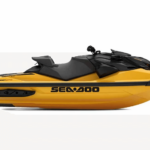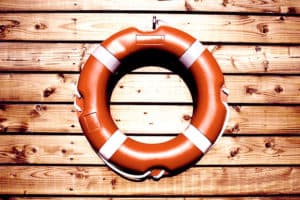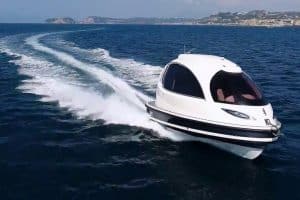Stainless steel is one of the best and most common materials used for boat propellers. Other popular alloys are aluminum, bronze, and nickel. In this article, I’ll address if a stainless steel prop will increase the speed of your boat.
Will a stainless steel prop increase speed? A stainless steel prop will certainly increase the speed of your boat. It provides faster acceleration, an average of 2 to 3 knots more than other alloys.
It gives better control and less flex at top speeds. It also gives you a better holeshot (meaning you can easily get up on a plane and catch speed from a stop position).
Read on to learn more about stainless steel props, and how they work to increase speed.
Also, for excellent stainless steel prop, take a look at our top pick, the Turning Point Propeller 31502112 Express Right Stainless 3-Blade:
Click here to see it on Amazon.
Will a Stainless Steel Prop Increase Speed?
A stainless steel prop will increase the speed of your boat. It is lightweight and very smooth, allowing it to cut through the water.
- It provides faster acceleration (on average, 2 to 3 knots more)
- It gives better control when at max speed
- You can see a better holeshot (meaning you can easily get up on a plane and catch speed from a stop position)
- Even at top speed, you’ll experience less prop flex
- It’s way stronger and more durable
Cost of a Stainless Steel Prop
A great prop should make your boat go faster with more efficiency. Stainless steel props are relatively more expensive than the other kinds, but they will save you fuel costs due to their efficiency in the water.
While it’s true that you will need to shell out over two hundred dollars for a 3-blade stainless steel prop versus over a hundred bucks on other kinds (e.g., aluminum), what you’ll be getting is value for money as the stainless steel prop is longer-lasting, gives you speed and fuel efficiency, and better handling.
Stainless Steel Props Vs. Other Materials
Our star for today is the stainless steel propeller. But to further help you examine your options, we’ll briefly show you the other players out there so you can better appreciate how they are different from their stainless counterparts.
Aluminum
Props made of aluminum are another popular metal used for propellers because they are highly affordable. They’re also a good option for boats that are small and medium in size.
Aluminum is more pliable and therefore aids in protecting drive components by readily ‘cushioning’ impact energy. So it can be a good choice for areas where the prop is prone to damage because of shallower waters or debris in the water.
Many stainless steel props have traces of aluminum blended in to make the prop more pliable.
Bronze
Mostly utilized on early boats, these props are still around even at present – like in ski boats – primarily because they are rather durable and flex minimally.
Bronze props are highly resistant to corrosion and fatigue, making them a great choice for bigger inboard, open water transport. The negative is that they are more difficult to repair than stainless steel if damaged.
Composite/Nibral
This alloy material is a combination of aluminum and bronze, and for added strength, nickel. It also does not corrode easily. Props made of composite material are the typical choice among boaters who want to upgrade their props from aluminum in a less costly way.
Given that you’re already thinking of buying a new stainless steel prop, I’ll give a quick review of certain points that you need to consider when choosing a propeller for your boat.
What to Look for When Buying a Propeller
Cross Measure/Span
A prop’s diameter, size, or span is an essential element that determines how powerful the propulsion is. Logically, the bigger the propeller, the more forceful is the thrust, and larger amounts of water are moved.
Propeller Pitch
A prop’s up and down rotational motion, aka pitch, pertains to how far through the water it moves in a revolution. Every inch of movement is actually equivalent to 200 RPM. For instance, a propeller with a 12-inch pitch is supposed to move 12 inches through a soft solid after each full rotation.
In water, though, there is a natural, slight element of drag or ‘slippage’ necessary for boat movement. So in our example, the prop tends to actually move a bit less than 12 inches in the water.
Number of Blades
It’s interesting to note that a propeller with more blades makes for smoother propulsion, but it also means that the movement tends to affect efficiency a bit. Usually, to address this issue, the use of three blades is the alternative, but nowadays, four blades have become another option.
Before reading on, you might want to check out this YouTube video:
Spin
Propellers rotate either to the right or clockwise or to the left or counterclockwise. Actually, there is really no difference in terms of thrust, and it’s all a case of how the blades are turned. After all, prop blades are shaped in a twisted way or turned to push against the air or water. Some boats use two counter-spinning props.
Density
For better speed and efficiency, prop blades need to be as thin (though sturdy) as possible. Thick blades require more power to propel.
Cupping
Modern-day props now have a cup found at the trailing edge of the blade. This cup-like lip is intended to provide a better grip on the water, translating to decreased slipping and ventilation. When this happens, the prop can accelerate faster from any position (i.e., holeshot). This feature also allows the prop to have a soaring top-end speed.
Ventilation
OK, you might wonder what “air” has got to do with boat propeller performance. It simply refers to when air from the surface or gases from the exhaust is sucked into the blades. Whenever this takes place, the speed is compromised and the motor’s RPM works double-time.
This can stem from factors like high mounting of the engine on the stern’s beam, overly tight cornering, or when you over-trim the motor.
Cavitation
Not to be confused with ventilation, cavitation happens when water vaporizes or boils because of the extreme decrease in pressure at the back of the prop blade. A lot of props slightly ‘cavitate’ in the course of normal running, but when this is overdone, it can ruin the blade surface of the propeller after the microscopic bubbles on the blade dissipate.
Cavitation may be caused by factors such as improper matching of prop style to application, blade damage, and even when the pitch is not right. It can also be brought about by obstruction in the water flow due to parts of the hull or running gear positioned too close to the propeller itself.
Now, after knowing all these considerations, including the fact that a stainless steel prop increases speed, you are now ready to do your shopping. And for sure, you’d want no less than the props that have been tried and tested.
If you’re wondering what are the best stainless steel props out there on the market, here are some highly recommended products for you to choose from:
Stainless Steel Props: Our Top 5 Picks
1. Turning Point Propeller 31502112 Express Right Stainless 3-Blade
This 3-blade propeller by Turning Point has a size of 14-1/4 x 21 and has a left-rotating version. The 15-5 stainless steel makes it stronger with age.
Click here to see it on Amazon.
For added boat lift and better boat performance, this prop produces higher rake angles, thereby tightening the vortex. Its tuned vents allow quicker holeshot, while its progressive pitch angles help minimize slippage and promote fuel efficiency.
See this review on the Turning Point 3-Blade propeller:
2. Quicksilver Thunderbolt Propeller High Polished Stainless Finish
This 3-blade Thunderbolt propeller from Quicksilver comes in left and right versions. Among the high-horsepower models, this particular series is touted as the best-selling one in the world.
Click here to see it on Amazon.
The Quicksilver Thunderbolt fits most stern drive motors and 135+ hop outboards through the appropriate Flo Torq II hub system, and its large span design works well across a broad range of applications.
Click here to see it on Amazon.
This prop is commonly purchased with the Quicksilver Flo-Torq II hub kit. Check out the video below, which explains in detail the Flo-Torq II.
3. Solas HR Titan 4-Blade Stainless 14” Diameter x 21” Pitch SR
The Solas HR Titan measures 14 inches in diameter with a 21-inch pitch.
Click here to see it on Amazon.
With its powerful four blades, this Solas prop is compatible with most leading engine brands like Honda, Mercury, and MerCruiser. It is light at only 10 pounds and comes with a horsepower of 135 and 115-225.
It provides excellent acceleration, stern lift, and propulsion, especially with its high rake blade and large cupping. Check out this Solas HR Titan review:
4. Turning Point Propeller 31501731 Express Right Stainless 4-Blade Propeller
Another product from Turning Point, this 4-blade prop weighs 14 pounds and is available in left and right rotating models.
Click here to see it on Amazon.
Similar to its 3-blade counterpart featured earlier, this 31501731 series is made from 15-5 stainless steel and promises superb handling and further boat lift through its cupping and aggressive rake. Likewise, you get faster holeshots and thrust while maintaining fuel efficiency.
5. Mercury Enertia 3 Blade SS Propeller 15 x 15 Pitch
The Mercury Enertia 3-blade prop weighs 17.56 pounds and is 15 inches in diameter with a 15-inch pitch.
Click here to see it on Amazon.
This right-hand rotation prop comes with the Flo-Torq II Hub Kit and Performance Vent System for solid fittings. This Enertia model is the first propeller to use the new X7 patented alloy for added strength and durability.
The durability goes beyond the capacity of traditional stainless steel, reputably four times stronger.
This prop promises improved acceleration and top speed on most deep boats controlled by outboards with high horsepower.
Check out this overview on the Mercury Enertia:
Conclusion – Will a Stainless Steel Prop Increase Speed?
To recap, will a stainless steel prop increase speed? The answer is yes. A stainless steel prop will increase the speed of your boat with faster acceleration (about 2 to 3 knots more).
Stainless steel doesn’t flex as much as other materials, so it will give greater control at top speeds. It also gives you a better holeshot (meaning you can easily get up on a plane and catch speed from a stop position).
Remember, if you’re after speed, better acceleration, better handling, and durability, you shouldn’t think long and hard about getting or upgrading to a stainless steel prop.
Related reading:
Can You Run a Boat with a Bent Prop?









